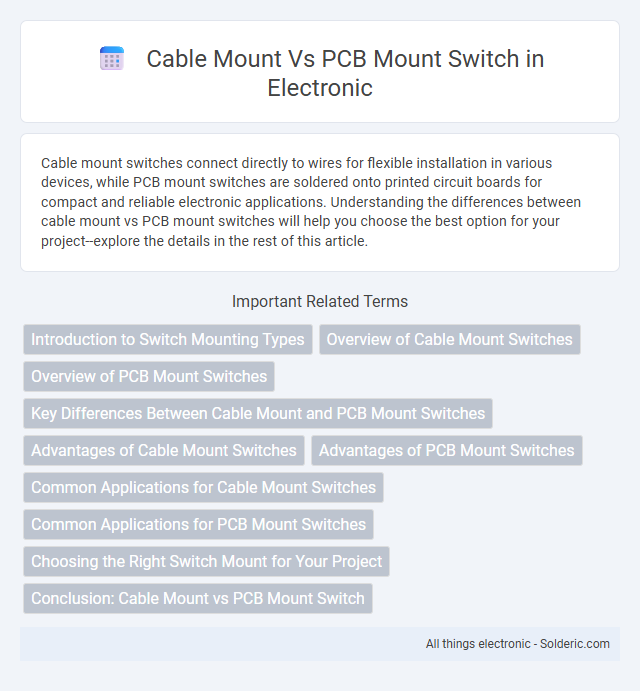Cable mount switches connect directly to wires for flexible installation in various devices, while PCB mount switches are soldered onto printed circuit boards for compact and reliable electronic applications. Understanding the differences between cable mount vs PCB mount switches will help you choose the best option for your project--explore the details in the rest of this article.
Comparison Table
| Feature | Cable Mount Switch | PCB Mount Switch |
|---|---|---|
| Mounting Type | Mounted via cable connections | Directly mounted on printed circuit board (PCB) |
| Installation | Flexible installation, easy to replace | Permanent soldered installation |
| Space Efficiency | Requires more space due to cables | Compact, saves PCB space |
| Durability | Cable connectors prone to wear | More reliable due to fixed soldering |
| Signal Integrity | Potential interference in cables | Better signal integrity on PCB |
| Cost | Higher due to cables and connectors | Lower overall with direct PCB mount |
| Applications | Used in flexible, modular setups | Used in compact electronics, embedded designs |
Introduction to Switch Mounting Types
Switch mounting types primarily include cable mount and PCB mount, each designed for specific applications and installation methods. Cable mount switches feature connectors for direct wiring, providing flexibility in positioning and ease of replacement, while PCB mount switches are soldered directly onto printed circuit boards, ensuring compactness and stable electrical connections. Choosing the right type depends on your device's design requirements, space constraints, and maintenance preferences.
Overview of Cable Mount Switches
Cable mount switches feature flexible wiring options ideal for applications requiring remote switch placement or frequent repositioning. These switches connect via cables rather than direct soldering onto a circuit board, offering enhanced durability and ease of maintenance. Your choice of cable mount switch ensures simplified installation in custom or space-constrained environments.
Overview of PCB Mount Switches
PCB mount switches are designed for direct soldering onto printed circuit boards, offering reliable mechanical and electrical connectivity with compact integration. These switches support surface-mount or through-hole technology, enabling automated assembly processes and enhanced durability in electronic devices. Their precise placement on PCBs minimizes space usage and improves signal integrity compared to cable mount switches.
Key Differences Between Cable Mount and PCB Mount Switches
Cable mount switches feature leads or wires for flexible connection to external circuits, making them ideal for applications requiring easy replacement or adjustment. PCB mount switches have pins designed for direct soldering onto printed circuit boards, ensuring a compact, stable, and reliable electrical connection. The primary differences lie in installation methods, mechanical stability, and suitability for specific circuit designs or enclosure constraints.
Advantages of Cable Mount Switches
Cable mount switches offer enhanced flexibility in device design by allowing placement away from the main PCB, suitable for tight or complex assemblies. They simplify maintenance and replacement since the switch can be detached without desoldering, reducing repair time and costs. These switches also provide better vibration resistance and improved durability in harsh environments due to isolated mounting and robust cable connections.
Advantages of PCB Mount Switches
PCB mount switches offer enhanced stability and reliable electrical connections directly on the circuit board, reducing the risk of loose wiring and improving overall device durability. Their compact design allows for efficient use of space within electronic assemblies, making them ideal for high-density applications. You benefit from simplified assembly and maintenance processes due to the secure, soldered connection that minimizes mechanical stress and potential failures.
Common Applications for Cable Mount Switches
Cable mount switches are commonly used in applications requiring flexible placement and ease of installation, such as remote controls, industrial machinery, and medical devices. Their design allows for quick connection and disconnection in environments where wiring changes may be frequent or accessibility is limited. These switches are ideal for portable equipment and systems needing reliable, customizable input solutions without permanent mounting constraints.
Common Applications for PCB Mount Switches
PCB mount switches are commonly used in electronic devices such as keyboards, control panels, and home appliances where compact and reliable connections are essential. These switches offer easy integration onto printed circuit boards, enabling efficient mass production and consistent performance in consumer electronics and industrial equipment. Your projects benefit from the space-saving design and durability PCB mount switches provide, especially in applications requiring precise and stable electrical contacts.
Choosing the Right Switch Mount for Your Project
Selecting between cable mount and PCB mount switches hinges on your project's design requirements and space constraints. Cable mount switches offer flexible wiring options and ease of installation in custom enclosures, making them ideal for prototypes and applications where PCB space is limited. PCB mount switches provide streamlined integration directly onto circuit boards, enhancing reliability and reducing assembly time in compact, high-density electronics.
Conclusion: Cable Mount vs PCB Mount Switch
Cable mount switches offer flexibility and easy installation, making them ideal for applications requiring quick replacements or adjustments. PCB mount switches provide a compact, reliable connection with enhanced durability suited for high-density circuit boards and automated assembly lines. Choosing between cable mount and PCB mount switches depends on your project's space constraints, durability needs, and maintenance preferences.
cable mount vs PCB mount switch Infographic

 solderic.com
solderic.com